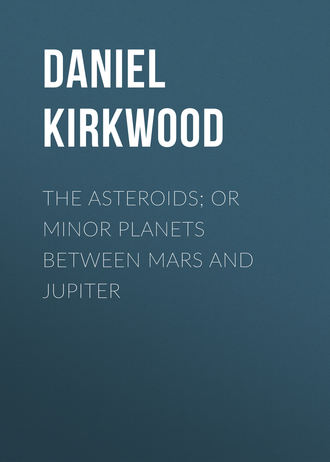 полная версия
полная версияThe Asteroids; Or Minor Planets Between Mars and Jupiter
It has been stated that the gap at the distance 3.277 is the only one corresponding to the first order of commensurability. The distance 3.9683, where an asteroid's period would be two-thirds of Jupiter's, is immediately beyond the outer limit of the cluster as at present known; the mean distance of Hilda being 3.9523. The discovery of new members beyond this limit is by no means improbable. Should a minor planet at the mean distance 3.9683 attain an eccentricity of 0.3—and this is less than that of eleven now known—its aphelion would be more remote than the perihelion of Jupiter. Such an orbit might not be stable. Its form and extent might be greatly changed after the manner of Lexell's comet. Two well-known comets, Faye's and Denning's, have periods approximately equal to two-thirds of Jupiter's. In like manner the periods of D'Arrest's and Biela's comets correspond to the hiatus at 3.51, and that of 1867 II. to that at 3.277.
Of the thirteen telescopic comets whose periods correspond to mean distances within the asteroid zone, all have direct motion; all have inclinations similar to those of the minor planets; and their eccentricities are generally less than those of other known comets. Have these facts any significance in regard to their origin?
APPENDIX
NOTE A
THE POSSIBLE EXISTENCE OF ASTEROIDS IN UNDISCOVERED RINGSIf Jupiter's influence was a factor in the separation of planetules at the sun's equator, may not similar clusters exist in other parts of our system? The hypothesis is certainly by no means improbable. For anything we know to the contrary a group may circulate between Jupiter and Saturn; such bodies, however, could not be discovered—at least not by ordinary telescopes—on account of their distance. The Zodiacal Light, it has been suggested, may be produced by a cloud of indefinitely small particles related to the planets between the sun and Mars. The rings of Saturn are merely a dense asteroidal cluster; and, finally, the phenomena of luminous meteors indicate the existence of small masses of matter moving with different velocities in interstellar space.
NOTE B
THE ORIGIN AND STRUCTURE OF COSMICAL RINGSThe general theory of cosmical rings and of their arrangement in sections or clusters with intervening chasms may be briefly stated in the following propositions:
IWhenever the separating force of a primary body on a secondary or satellite is greater than the central attraction of the latter on its superficial stratum, the satellite, if either gaseous or liquid, will be transformed into a ring.
Examples.—Saturn's ring, and the meteoric rings of April 20, August 10, November 14, and November 27.
See Payne's Sidereal Messenger, April, 1885.
IIWhen a cosmical body is surrounded by a ring of considerable breadth, and has also exterior satellites at such distances that a simple relation of commensurability would obtain between the periods of these satellites and those of certain particles of the ring, the disturbing influence of the former will produce gaps or intervals in the ring so disturbed.
See "Meteoric Astronomy," Chapter XII.; also the Proceedings of the American Philosophical Society, October 6, 1871; and the Sidereal Messenger for February, 1884; where the papers referred to assign a physical cause for the gaps in Saturn's ring.
THE END1
The discoverer, Piazzi, was not, as has been so often affirmed, one of the astronomers to whom the search had been especially committed.
2
Massalia was discovered by De Gasparis, at Naples, Sept. 19, 1852, and independently, the next night, by Chacornac, at Marseilles. The name was given by the latter.
3
Astr. Nach., No. 932.
4
Monthly Notices, vol. xxvii.
5
Annals of the Obs. of Harv. Coll., 1879.
6
This ingenious idea may be readily extended. The least distance of Æthra is less than the present aphelion distance of Mars; and the maximum aphelion distance of the latter exceeds the perihelion distance of several known asteroids. Moreover, if we represent the orbits of the major planets, and also those of the comets of known periods, by material rings, it is easy to see that the major as well as the minor planets are all linked together in the manner suggested by D'Arrest.
7
The effects of Jupiter's disturbing influence will again be resumed.
8
Not only nebulæ are probably unstable, but also many of the sidereal systems. The Milky Way itself was so regarded by Sir William Herschel.
9
Menippe, No. 188, is placed in one of the gaps by its calculated elements; but the fact that it has not been seen since the year of its discovery, 1878, indicates a probable error in its elements.
10
The minor planet Andromache, immediately interior to the critical distance 3.51, has elements somewhat remarkable. With two exceptions, Æthra (132) and Istria (183), it has the greatest eccentricity (0.3571),—nearly equal to that of the comet 1867 II. at its last return. Its perihelion distance is 2.2880, its aphelion 4.7262; hence the distance from the perihelion to the aphelion of its orbit is greater than its least distance from the sun, and it crosses the orbits of all members of the group so far as known; its least distance from the sun being considerably less than the aphelion of Medusa, and its greatest exceeding the aphelion of Hilda.
11
The unit being the sun's distance from the earth.
12
Annuaire, 1886.

